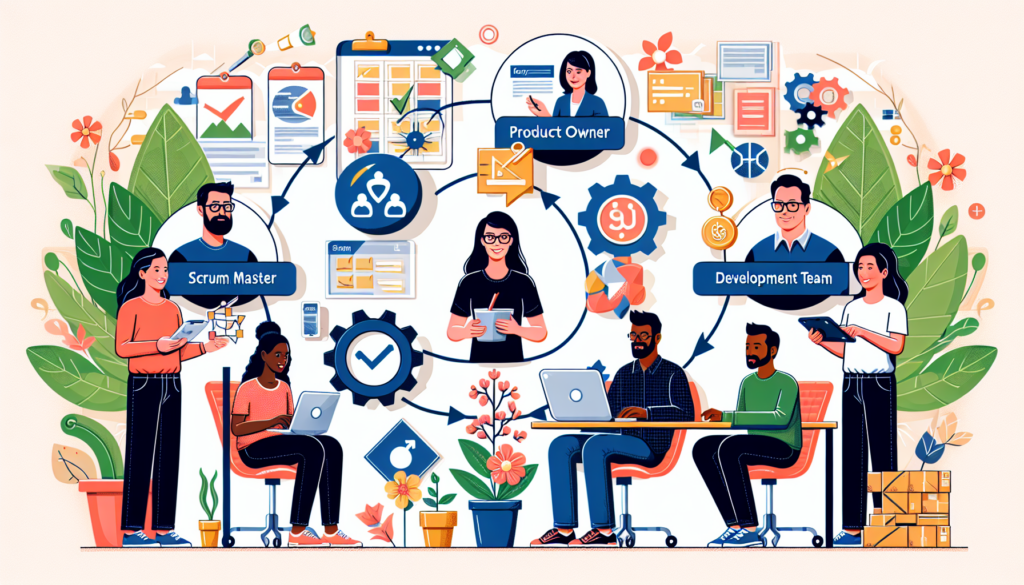In the dynamic environment of Agile processes, roles such as Scrum Master, Product Owner, and Development Team have become fundamental pillars for achieving an iterative and adaptive cycle in project management. These roles form a collaborative ecosystem where efficiency and continuous improvement are the result of a perfectly orchestrated synergy. Delving into their specific roles, responsibilities, and how they interact with each other, provides valuable understanding for any entity that aspires to imbibe the Agile spirit.
Scrum Master: Facilitator and Guide
Critical Functions and Specific Attributes
The Scrum Master acts as a facilitator, ensuring that the Development Team works synergistically and efficiently within the Scrum framework. They are responsible for removing obstacles and ensuring that Agile practices are followed, fostering an environment where communication and collaboration flow unhindered.
This role demands a thorough understanding of Agile principles and values. The Scrum Master must be a mentor guiding the team toward self-sufficiency and self-management. This figure, possessing skills in servant leadership, is essential for building a work dynamic based on trust and self-accountability.
Dynamic Impact on the Agile Team
The Scrum Master’s involvement is crucial during Scrum ceremonies, such as sprints, daily stand-ups, sprint reviews, and retrospectives. Their ability to mediate and encourage the team’s self-organization enhances the effectiveness of these meetings, leading to better identification of risks and opportunities for improvement.
Product Owner: The Voice of Value
Product Strategist and Prioritization
The Product Owner materializes the product vision within the Scrum team. They focus on defining product features (user stories), managing the product backlog, and prioritizing tasks based on the value they bring to the business. They must maintain a strategic focus with negotiation and analysis skills to maximize the return on investment (ROI).
Connection between Stakeholders and Development Team
This role acts as a link between the business and the technical team, ensuring there is a clear understanding of what is needed and why. For this, it is essential that the Product Owner has communication skills and establishes clear acceptance criteria that align expectations and outcomes.
Focus on Continuous Value Delivery
As the ultimate responsibility for the backlog, the Product Owner plays a key role in the development lifecycle, ensuring that the team focuses on tasks that provide the most significant value to the end customer.
Development Team: Innovation and Execution
Multidisciplinary Profiles and Self-organization
The Development Team is the engine that turns the Product Owner’s vision into a functional product. It consists of professionals from different disciplines who collaborate closely, sharing the responsibility for delivering high-quality product increments at the end of each Sprint.
Commitment to Improvement and Quality
Development Team members must be proactive in identifying and adopting best practices and quality standards. Collaboration and communication are vital, therefore they are expected to have a high level of commitment to ensure transparency and adaptability to challenges.
Incremental Delivery and Adaptability
The nature of the team’s work involves incremental delivery of solutions, which requires them to be adaptable and strongly oriented toward measurable outcomes. Technical mastery and time management skills are essential competencies for efficiently meeting sprint goals.
Synergistic Interaction and Holistic Vision
Collaboration and Communication
The interaction between the Scrum Master, Product Owner, and Development Team must be fluid, based on mutual respect and trust. Collaboration is key and is encouraged through effective communication and a clear understanding of common objectives.
Conflict Management and Decision Making
The Scrum Master plays a crucial role in resolving conflicts, while the Product Owner must make informed and timely decisions that affect the product. The Development Team requires an environment that promotes self-management and a conducive atmosphere for innovation.
Conclusions and Future Projections
Continuous Improvement and Agility
The constant evolution of Agile practices demands that these roles adapt and evolve. Successes and failures should be used as a platform for learning and continuous improvement. Only through consistent introspection and adaptability can Agile teams keep pace with the changing market demands and customer expectations.
The integration of these roles creates a dynamic ecosystem that drives organizations toward greater efficiency and better performance. As Agile matures, we are likely to see an evolution in how these responsibilities are understood and applied, with each role adapting to emerging technologies and innovative methodologies. Current case studies demonstrate how effective implementation of these roles can lead to the successful delivery of complex and highly technical products in sectors such as software, automotive, and information technology.

